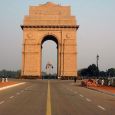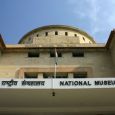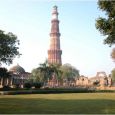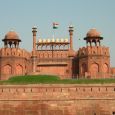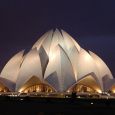Delhi
Advertisement
Airports
Indira Gandhi International Airport (IGI) serves Delhi for both domestic and international connections, and is situated in the southwestern corner of the city, alongside Delhi-Gurgaon Expressway. In the year 2006-2007, IGI recorded a traffic of 20.44 million passengers. It is currently the busiest airport in South Asia.[24] It operates two terminals — Terminal 1 for domestic and Terminal 2 for international air travel.
The airport is witnessing massive expansion and modernisation by a consortium led by GMR. The airport will get a new integrated Terminal 3 by 2010. Terminals 4, 5 and 6 will be built in a phased manner. By 2024, airport will have four runways and will handle more than 100 million passengers per year, which is more than what Atlanta airport (world's busiest airport) handles now[25].
Apart from the expanded IGI airport, Delhi might also receive a second airport by 2012-2013. The airport, being named as Taj International Aviation Hub, is proposed be located in Jewar in Greater Noida. It would be 75 km from IGI airport.
Rail transport
Rail based transport in the city has started to gain-popularity with the introduction of Delhi Metro. Ring-Railway, which runs parallel to the Ring-Road system is another rail-based intra-city transport facility in Delhi.
Metro
Rapid increase of population coupled with large-scale immigration due to high economic growth has resulted in ever increasing demand for better transport, putting excessive pressure on the city's existent transport infrastructure. Like many other cities in the developing world, the city faces acute transport management problems leading to air pollution, congestion and resultant loss of productivity. In order to meet the transportation demand in Delhi, the State and Union government started the construction of an ambitious Mass Rapid Transit system, known as [5] Delhi Metro in 1998. The project started commercial operations on December 24, 2002. It has set many performance and efficiency standards ever since and is continuously expanding at a very rapid pace. As of 2010, the metro operates 5 lines with a total length of 111 km[15] and 98 stations[16] while several other lines are under construction.
Buses
Delhi has one of India's largest bus transport systems. Buses are the most popular means of transport catering to about 60% of Delhi's total demand.[8] Buses are operated by the state-owned Delhi Transport Corporation (DTC), which owns largest fleet of Compressed Natural Gas (CNG)-fueled buses in the world, private Blueline bus operators and several chartered bus operators. It is mandatory for all private bus operators to acquire a permit from the State Transport Authority. The buses traverse various well-defined intra-city routes. Other than regular routes, buses also travel on Railway Special routes; Metro Feeder routes. Mudrika (Ring) and Bahri Mudrika (Outer Ring) routes along Ring and Outer-Ring road respectively are amongst the longest intra-city bus routes in the world.
With the introduction of Bus Rapid Transit (BRT) and the development of dedicated corridors for the service, bus service is set to improve. The DTC has started introducing air-conditioned buses and brand new low-floor buses (with floor height of 400 mm and even higher on one third area as against 230 mm available internationally.) on city streets to replace the conventional buses. A revamp plan is underway to improve bus-shelters in the city and to integrate GPS systems in DTC buses and bus stops so as to provide reliable information about bus arrivals.
In 2007, after public uproar concerning the large number of accidents caused by privately-owned Blueline buses, the Delhi government, under pressure from the Delhi High Court decided that all Blueline Buses shall be phased out and be eventually replaced by low floor buses of the state-owned DTC.[9] The Delhi Government has decided to expedite this process and will procure 6,600 low floor buses for the DTC by commonwealth games next year.[10]
By 2010, Delhi will have over 8000 buses, of which Delhi Transport Corporation will provide 6000 while 2000 would be blueline buses, 3125 will be low-floor ,1100 semi low floor and 1000 of them would be air-conditioned. Few buses would have GPS to prevent them from straying to other routes. The city already has 655 low-floor AC and non-AC buses. The bus routes are also being increased to 670 from the current 357 routes. Delhi plans to add at least 2500 of these new buses by the end of 2009.[11] The city has been divided into 17 clusters. Bus services in each of these clusters will be run by private operators. The first cluster is to be awarded by September 2008. The first cluster has 32 routes, on which a total of 295 DTC and 270 private buses will run. The operators will be given the option of running 20 percent AC buses[12] With the introduction of new buses, DTC will be recruiting 4000 drivers to run the new buses.
Taxis
Recently, Radio Taxis have started to gain ground in Delhi. Brands such as Mega Cabs, EasyCabs, etc., provide the on-call radio taxi service, which is slightly more expensive than conventional Black and Yellow taxis. Other than these two mentioned, companies such as Hertz Car Rental and Avis Car Rental provide rent-a-car service.
Red Fort
The decision for constructing the Red Fort was made in 1639, when Shah Jahan decided to shift his capital from Agra to Delhi. Within eight years, Shahjahanabad was completed with the Red Fort-Qila-i-Mubarak (fortunate citadel) — Delhi's seventh fort — ready in all its magnificence[citation needed] to receive the Emperor. Though much has changed with the large-scale demolitions during the British occupation of the fort, its important structures have survived.
Qutub Minar
The Qutub Minar is located in a Mehrauli in South Delhi. It was built by Qutb-ud-din Aibak of the Slave Dynasty, who took possession of Delhi in 1206. It is a fluted red sandstone tower, which tapers up to a height of 72.5 metres and is covered with intricate carvings and verses from the Qur'an. Qutub-ud-din Aybak began constructing this victory tower as a sign of Muslim domination of Delhi and as a minaret for the muezzin to call the faithful to prayer. However, only the first story was completed by Qutub-ud-din. The other stories were built by his successor Iltutmish. The two circular stories in white marble were built by Ferozshah Tughlaq in 1368, replacing the original fourth story.
The balconies in the tower are supported by exquisite stalactite designs. The tapering tower has pointed and circular flutings on the first storey and star-shaped ones on the second and third stories.
The Qutub Minar is also significant for what it represents in the history of Indian culture. In many ways, the Qutub Minar, the first monument built by a Muslim ruler in India, heralded the beginning of a new style of art and architecture that came to be known as the Indo-Islamic style. Other monuments around the Qutb complex, are Jamaali Kamaali mosque and tombs, Balban's tomb and Adham Khan's Tomb.
Lotus Temple Delhi
Lotus Temple DelhiLocated in Kalkaji in the south of Delhi, it is lotus shaped and has rightly been given the name. It is made of marble, cement, dolomite and sand. It is open to all faiths and is an ideal place for meditation and obtaining peace and tranquility.
It is a very recent architectural marvel of the Bahai faith. The Bahá'í Faith is the youngest of the world's independent religions. Its founder, Bahá'u'lláh (1817-1892), is regarded by Bahá'ís as the most recent in the line of Messengers of God that stretches back beyond recorded time and that includes Abraham, Moses, Buddha, Zoroaster, Christ and Muhammad. The central theme of Bahá'u'lláh's message is that humanity is one single race and that the day has come for its unification in one global society. God, Bahá'u'lláh said, has set in motion historical forces that are breaking down traditional barriers of race, class, creed, and nation and that will, in time, give birth to a universal civilization. The principal challenge facing the peoples of the earth is to accept the fact of their oneness and to assist the processes of unification.
National museum
The largest museum of New Delhi, the National museum at Janpath, offers a unique insight into the history and culture of India. It has a wide array of exhibits, depicting the 5000 years of Indian history. The three floors of the museum offer splendid and priceless pieces of Indian art and sculpture that have been arranged in galleries, according to the period to which they belong. The famous sculpture of Dancing Girl from Mohenjodaro belonging to 2,500 BC, the Moghul period paintings & Arabian manuscripts are some of the prized possessions here.
The silk banners, sculpture and wall paintings that were a part of Sir Aurel Stein's collection in the Central Asian gallery are worth seeing here. A collection of Indian miniature paintings, from Mughal, Rajasthani and Pahari schools, and simple stone Neolithic Tools, dating back to 3,000 -1,500 BC, are simply outstanding. Then, there is shell and bone jewelry belonging to Indus Valley Civilization of Mohenjodaro and Harappa and also the carved pillars and statues of the Mauryan dynasty.
The fine bronze idols, stone sculpture, textiles, coins and tribal art are all exhibited at the National Museum of Delhi. The men love the display of weapons and historical costumes on the third floor, while the display of over 300 musical instruments in the museum awes the music lovers. The more inquisitive ones can also attend the film shows on the art heritage of India on weekdays at 2:30 pm and on weekends at 11:30 am, 2:30 pm and 4:00 pm. The museum remains closed on Mondays.
India Gate
India Gate is constructed as a memorial and was built in the memory of 90,00 soldiers who laid down their lives during world war I. Located at Rajpath, India Gate is 42 m high and is popular relaxation area during the summer evenings. India Gate also act as popular pinic spot during winter. Also known as the All India War Memorial, India Gate was designed and constructed by Lutyens. He was the who is considered the chief proclaimer in designing the New Delhi plans.
November - January


